
In today’s digital age, how can you prevent viruses and malicious code is more important than ever. Cyber threats are constantly evolving, making it crucial to stay informed and vigilant. But don’t worry, I’m here to help you navigate the complex world of cybersecurity. Let’s dive into how to prevent viruses and malicious code from wreaking havoc on your devices and personal information.
Understanding Viruses and Malicious Code
Definition of Viruses
A virus is a type of malicious software (malware) designed to replicate itself and spread from one computer to another. It attaches itself to legitimate programs or files, often without the user’s knowledge, and can cause significant damage by corrupting or deleting data, stealing sensitive information, and more.
Types of Malicious Code
Malicious code encompasses a variety of threats beyond viruses, including:
- Worms: Self-replicating programs that spread without user intervention.
- Trojans: Malicious programs disguised as legitimate software.
- Spyware: Software that secretly monitors and collects user information.
- Ransomware: Malware that encrypts files and demands payment for their release.
Common Sources of Viruses and Malicious Code
Infected Email Attachments
Emails remain a primary vector for delivering malicious code. Cybercriminals often use phishing emails with infected attachments or links to lure victims.
Malicious Websites
Visiting compromised or malicious websites can lead to automatic downloads of malware, known as drive-by downloads.
Downloadable Software
Downloading software from untrusted sources increases the risk of inadvertently installing malicious programs.
Removable Media
USB drives and other removable media can carry viruses that infect computers when plugged in.
Basic Prevention Techniques
Regular Software Updates
Keeping your operating system and software up to date is crucial. Updates often include patches for security vulnerabilities that cybercriminals could exploit.
Use of Antivirus Programs
Installing reputable antivirus software provides a first line of defense by detecting and removing known threats. Ensure your antivirus software is always up to date.
Enabling Firewalls
Firewalls act as barriers between your computer and potential threats from the internet. Make sure your firewall is enabled and properly configured.
Safe Browsing Practices
Be cautious when browsing the internet. Avoid clicking on suspicious links or downloading files from untrusted websites.
Advanced Protection Strategies
Utilizing VPNs
A Virtual Private Network (VPN) encrypts your internet connection, protecting your data from eavesdroppers and hackers, especially on public Wi-Fi networks.
Implementing Multi-Factor Authentication
Multi-factor authentication (MFA) adds an extra layer of security by requiring additional verification beyond just a password.
Regular Data Backups
Regularly backing up your data ensures you can recover important files in case of a malware infection or other data loss incidents.
Intrusion Detection Systems
Intrusion detection systems (IDS) monitor network traffic for suspicious activity and alert you to potential threats.
Educating Yourself and Others
Recognizing Phishing Attempts
Learn to identify phishing emails and messages, which often appear to come from legitimate sources but aim to steal personal information.
Safe Email Practices
Don’t open attachments or click on links in unsolicited emails. Verify the sender’s authenticity before interacting with any email content.
Awareness Training for Employees
If you run a business, conduct regular cybersecurity training for your employees to ensure they understand how to recognize and avoid threats.
Securing Personal Devices
Protecting Smartphones and Tablets
Install security apps and keep your mobile devices updated. Be cautious about the apps you download and the permissions you grant.
Secure Use of IoT Devices
Internet of Things (IoT) devices, like smart home gadgets, can be vulnerable to attacks. Change default passwords and update firmware regularly.
Best Practices for Businesses
Developing a Cybersecurity Policy
Create a comprehensive cybersecurity policy that outlines procedures for preventing and responding to cyber threats.
Regular Security Audits
Conduct regular security audits to identify and address potential vulnerabilities in your systems and networks.
Incident Response Plan
Develop an incident response plan to quickly and effectively deal with security breaches and minimize their impact.
Role of Operating Systems in Security
Windows Security Features
Windows offers built-in security features like Windows Defender and BitLocker. Keep these tools enabled and updated.
macOS Security Features
macOS includes security features such as Gatekeeper and XProtect. Utilize these tools and keep your system updated.
Linux Security Features
Linux users can enhance security by using tools like SELinux and regular software updates from trusted repositories.
Browser Security Measures
Importance of Secure Browsers
Choose secure browsers like Chrome or Firefox, which offer robust security features and regular updates.
Configuring Browser Settings
Adjust your browser settings to enhance security, such as enabling pop-up blockers and disabling third-party cookies.
Using Browser Extensions for Security
Consider using security-focused browser extensions, like ad blockers and anti-phishing tools, to add extra layers of protection.
Mobile Security
Downloading Apps from Trusted Sources
Only download apps from official app stores like Google Play or the Apple App Store to reduce the risk of installing malicious apps.
Regular Updates and Patches
Keep your mobile operating system and apps updated to protect against known vulnerabilities.
Mobile Antivirus Solutions
Consider installing a reputable mobile antivirus app to scan for and remove potential threats.
Importance of Strong Passwords
Creating Strong Passwords
Use complex passwords that include a mix of letters, numbers, and symbols. Avoid using easily guessable information.
Password Management Tools
Password managers can help you generate and store strong, unique passwords for all your accounts.
Avoiding Common Password Pitfalls
Avoid using the same password for multiple accounts and never share your passwords with others.
Social Engineering Tactics and Prevention
What is Social Engineering?
Social engineering involves manipulating people into revealing confidential information or performing actions that compromise security.
Examples of Social Engineering Attacks
Common attacks include pretexting, baiting, and impersonation, where attackers pose as trusted individuals or entities.
Preventing Social Engineering Attacks
Stay vigilant, verify the identity of individuals requesting sensitive information, and educate others about the risks.
Staying Updated with Cybersecurity Trends

Following Cybersecurity News
Stay informed about the latest cybersecurity threats and trends by following reputable news sources and blogs.
Participating in Cybersecurity Communities
Join online forums and communities where you can share knowledge and learn from others in the field.
Continuous Learning and Adaptation
Cybersecurity is an ever-evolving field. Regularly update your skills and knowledge to stay ahead of potential threats.
Conclusion
Preventing viruses and malicious code requires a multifaceted approach, combining basic and advanced security measures. By staying informed, using the right tools, and practicing safe behaviors, you can protect yourself and your devices from cyber threats. Remember, cybersecurity is an ongoing process—stay vigilant and proactive.
FAQs
1. What is the most effective way to prevent viruses?
The most effective way to prevent viruses is by using a combination of antivirus software, regular updates, and safe browsing practices.
2. Can antivirus software protect against all types of malware?
While antivirus software is crucial, it may not catch every threat. Combining it with other security measures, like firewalls and VPNs, provides better protection.
3. How often should I update my software?
Update your software as soon as updates are available. Most updates include security patches that address vulnerabilities.
4. What should I do if I suspect my device is infected?
If you suspect your device is infected, run a full antivirus scan, disconnect from the internet, and seek professional help if necessary.
5. Are mobile devices as vulnerable to viruses as computers?
Yes, mobile devices are also vulnerable to viruses and other malware. It’s important to use mobile security solutions and practice safe usage habits.
For additional strategies to safeguard your digital assets, check out our article on CER CYBERSECURITY: SAFEGUARDING VITAL RESOURCES.
